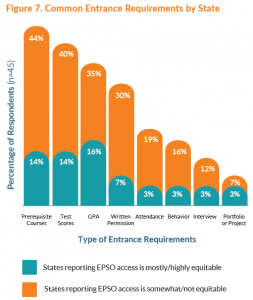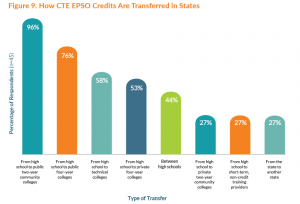This research review series features interviews with three CTE researchers— Julie Edmunds, Shaun Dougherty, and Rachel Rosen — to highlight new and relevant Career Technical Education (CTE) research topics being pursued and discuss how state CTE leaders might leverage these to make evidence-based decisions. This series is conducted in partnership with the Career and Technical Education Research Network, which is providing new CTE impact studies and strengthening the capacity of the field to conduct and use rigorous CTE research.
 For the final post in this series, Advance CTE caught up with researcher Shaun Dougherty to learn more about the outcomes of his study, The Effects of Career and Technical Education: Evidence from the Connecticut Technical High School System. This study took place at The Connecticut Technical High School System (CTHSS), an independent district of choice composed of 16 high schools where all students who attend the school participate in some form of CTE. The technical high schools in this study offer between 10 and 17 programs of study compared to the two to four typically offered at traditional comprehensive high schools. These findings suggest that student participation in CTE programs can improve graduation and college enrollment rates, and labor force participation, especially for male students. These findings should be meaningful to state leaders who are interested in improving CTE data quality to improve programming and learner supports.
For the final post in this series, Advance CTE caught up with researcher Shaun Dougherty to learn more about the outcomes of his study, The Effects of Career and Technical Education: Evidence from the Connecticut Technical High School System. This study took place at The Connecticut Technical High School System (CTHSS), an independent district of choice composed of 16 high schools where all students who attend the school participate in some form of CTE. The technical high schools in this study offer between 10 and 17 programs of study compared to the two to four typically offered at traditional comprehensive high schools. These findings suggest that student participation in CTE programs can improve graduation and college enrollment rates, and labor force participation, especially for male students. These findings should be meaningful to state leaders who are interested in improving CTE data quality to improve programming and learner supports.
How do your research findings advance the CTE field’s understanding of ways to better serve learners?
My findings in Connecticut and an earlier study in Massachusetts suggest that increasing access to high-quality CTE-focused schools can improve high school graduation rates, test scores, and early workforce experiences (earnings especially). These findings suggest that ensuring access to high-quality CTE is important, especially in areas where there is high demand for it among students. In Connecticut, we show that the benefits accrue to males only, but in Massachusetts, the impacts are broader-based and larger for students who come from less financially advantaged backgrounds.
What is also important about both of these contexts is that students are attending CTE-dedicated high schools, which is the least common form of CTE instructional delivery in the United States. Students explore multiple programs in 9th grade and then make an informed decision about what program of study to pursue for the rest of their high school experience. Within the program they choose, they then have a relatively stable set of peers and instructors, and there is alignment between content in the state graduation requirements, such as math and English Language Arts (ELA), and their technical area of study. Each of these dimensions of the experience tends not to exist in CTE delivered in comprehensive high schools or regional technical centers.
What findings would you highlight for state CTE leaders in particular?
In particular, I’d highlight the following:
- Whole-school models of CTE may be more expensive but have been shown to have quite larger impacts on student success and so could be worth the long-term investment.
- If whole-school models aren’t feasible, adapting some of the structures of how those schools operate in other settings could be worth pursuing.
- Creating ways for students to explore multiple programs of study early in high school is likely to improve the experience of all students as they get more information about their interests and strengths.
- Investing in skilled trade programs likely helps mitigate otherwise undesirable educational and social outcomes, especially for boys who struggled to be engaged in middle school. Avoiding tracking is critical, but also finding ways to engage students in ways that likely benefit them and their families and communities is critical.
You find male students enrolled in Connecticut’s Technical High School System (CTHSS) are more likely to graduate high school and experience a notable wage increase compared to males attending traditional high schools, yet this effect is not seen among female students. What do you make of this finding?
There are two things worth noting here:
- Male labor force participation in the U.S. is generally lower than females, as are their likelihoods of completing high school or entering college. Thus, there is more opportunity to have a positive impact on males than females.
- Males are more likely to enter traditionally male-dominated fields, such as manufacturing and construction, which are the two industries where we see the largest payoff for participating in these technical high schools. Thus, gendered patterns of program participation are related to similarly gendered patterns of employment, which are directly related to the earnings premiums we see for males.
Can you tell me about how you were able to leverage the state’s longitudinal data system, the value that this process brought to your work, and about any limitations you encountered??
We matched the CTHSS admissions records to the Connecticut State Department of Education’s (CSDE) longitudinal data system sequentially using the following criteria: SASID, exact match on first and last name plus birth year, first initial and exact match on last name plus birth year and month, and exact match on last name plus exact birth date. The reason for the sequential match process is reporting errors in the CTHSS application file on birth dates, spelling errors and uses of nicknames in the application file that parents and/or students fill out by hand. A failure to match after applying all of these criteria leads to the observation being omitted from the sample. Our resulting match rate was 95 percent yielding a final sample of 57,658 student applications.
From the CSDE longitudinal data system, we obtained information on each student’s race, gender, free or reduced-price lunch status, English learner and special education status (i.e. presence of an IEP).
The CSDE data also provided information on short- and medium-term educational outcomes including standardized test scores prior to and during high school, attendance, and high school graduation, as well as information on college attendance drawn from the National Student Clearinghouse.
Further, through the P20Win process, students in our sample were matched to Connecticut State Department of Labor (CSDOL) data. This CSDOL match is facilitated by Department of Motor Vehicle records that contain gender, birth date, and first and last name and is matched to the CSDOL data using social security numbers. CSDOL personnel then matched the resulting data to the CSDE data using an exact match on birth date and gender and a fuzzy match algorithm on the student’s name.
Failure to match applicants in the CSDOL data may have been driven by several factors including never having a driver’s license in the state of Connecticut, name changes due to marriage or other factors, moving out of state prior to or upon the completion of high school or failure to participate in the labor market after high school perhaps due to college attendance. Our labor market data ends in the 1st quarter of 2018. Therefore, we restrict this sample to the years 2006 to 2012 so that we have a potential for at least six quarters of data on each applicant.
Without the matching to the workforce outcomes, we would be left to wonder or speculate about what happened to most students, since there is no real evidence of impact on college-going (nor should we expect it early on for students who attended schools that emphasize manufacturing and skilled trades). Thus, the linkages were critical to being able to provide policymakers with relevant, detailed answers
The primary limitation is that we cannot see workers who moved out of state, who were employed by the federal government, who work for unreported wages, or who are independent contractors. However, our takeaway is that our findings are likely an underestimate of the benefits of CTE.
What new questions has this work raised for you that could be applied to future research?
The two biggest questions this work has raised for me so far are:
- First, what financial benefits will persist through middle age and beyond?
Other work has shown that early-career benefits of CTE may decline or turn negative over a 30-year career if the jobs and skills become obsolete or workers are not able to maintain their labor force participation. The evidence that raises this concern is from much earlier periods, so following this over the long term is critical.
- Second, are there conditions under which females see similar, or at least positive benefits? The gendered patterns of results are both informative and distressing. For instance, Sade Bonilla (2020) found larger high school graduation benefits from CTE in California where recent expansions of CTE had focused on health services pathways, which were both in demand and disproportionately female. Relatedly, it would be important to get other measures of benefits, such as job satisfaction, flexibility, or other indirect financial benefits. For example, females are more likely to go into education. For early childhood educators, there may be an indirect financial benefit in the form of free or reduced-cost childcare for one’s own children. Further, flexibility in work schedules around children’s school schedules may also carry weight in estimating benefits.
Visit the Learning that Works Resource Center for additional publications examining career-centered education models and Advance CTE’s 50-state report on equity in CTE early postsecondary opportunities (EPSOs) released earlier this year.
The work of the CTE Research Network Lead is supported by the Institute of Education Sciences at the U.S. Department of Education with funds provided under the Carl D. Perkins Career and Technical Education Act through Grant R305N180005 to the American Institutes for Research (AIR). The work of the Network member projects is supported by the Institute. The opinions expressed are those of the authors and do not represent the views of the Institute or the U.S. Department of Education.
Amy Hodge, Policy Associate




 When was College in High School Alliance (CHSA) established and who were its founders? Was there a catalyst for its inception?
When was College in High School Alliance (CHSA) established and who were its founders? Was there a catalyst for its inception? The Delaware Department of Education recently named Jon Wickert as its new Director, Career and Technical Education (CTE) and Science, Technology, Engineering, and Mathematics (STEM) Initiatives. His path to state CTE leadership reflects the power of career exploration and social capital that will sustain ‘The First State’s’ strong record of innovation and transformation of CTE systems.
The Delaware Department of Education recently named Jon Wickert as its new Director, Career and Technical Education (CTE) and Science, Technology, Engineering, and Mathematics (STEM) Initiatives. His path to state CTE leadership reflects the power of career exploration and social capital that will sustain ‘The First State’s’ strong record of innovation and transformation of CTE systems.  3.Identify and remove barriers to access, including restrictive costs or entrance requirements, and target specific learner populations for recruitment.
3.Identify and remove barriers to access, including restrictive costs or entrance requirements, and target specific learner populations for recruitment.  5.Expand statewide and inter-state articulation agreements to account for all types of CTE EPSOs. Statewide agreements can help guarantee recognition of CTE EPSO credit and facilitate automatic transfer between a secondary institution and a corresponding postsecondary institution of the learner’s choice. Ensuring that the transfer of credit is as frictionless as possible is vital to supporting learners as they transition into postsecondary education and continue in a degree program. As states work to ensure that each learner’s EPSO experiences consistently are counted toward articulated credit, they should also ensure that this credit contributes to core credits in a CTE program of study and not just elective credit. States can develop additional guidelines and legislation that ensures the connection between an EPSO and a program of study. Ohio has Career-Technical Assurance Guides (CTAGs) that provide automatically articulated and transferable credit upon completion of CTE coursework.
5.Expand statewide and inter-state articulation agreements to account for all types of CTE EPSOs. Statewide agreements can help guarantee recognition of CTE EPSO credit and facilitate automatic transfer between a secondary institution and a corresponding postsecondary institution of the learner’s choice. Ensuring that the transfer of credit is as frictionless as possible is vital to supporting learners as they transition into postsecondary education and continue in a degree program. As states work to ensure that each learner’s EPSO experiences consistently are counted toward articulated credit, they should also ensure that this credit contributes to core credits in a CTE program of study and not just elective credit. States can develop additional guidelines and legislation that ensures the connection between an EPSO and a program of study. Ohio has Career-Technical Assurance Guides (CTAGs) that provide automatically articulated and transferable credit upon completion of CTE coursework.